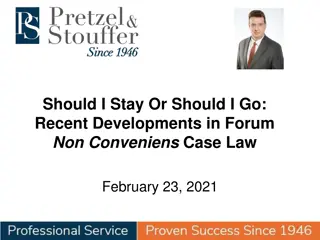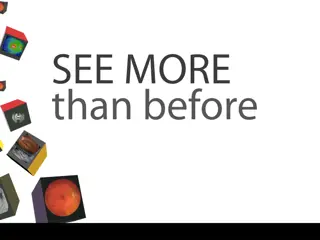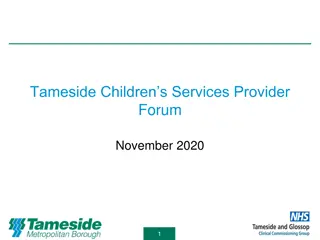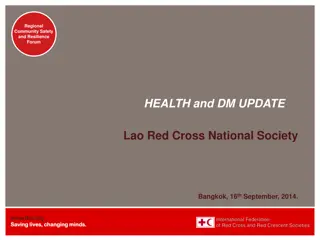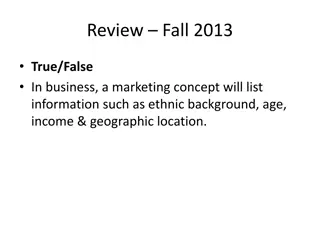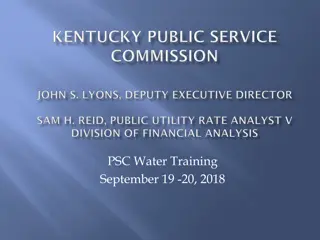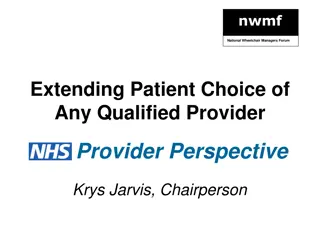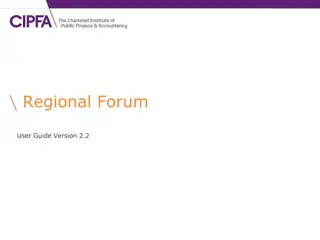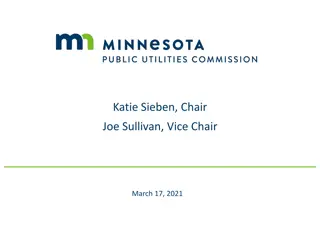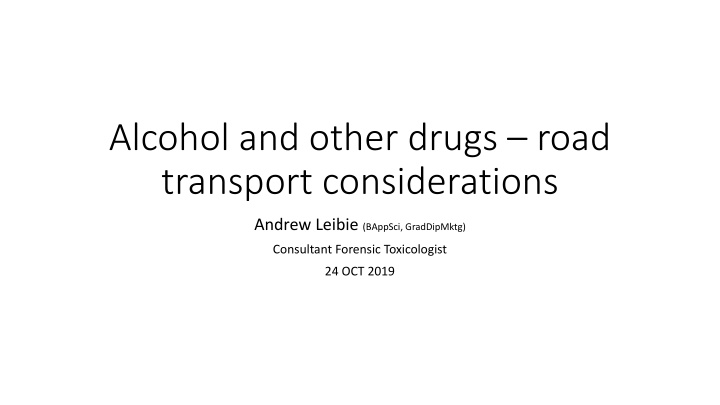
Road Transport Considerations: Alcohol and Other Drugs
"Explore important aspects of alcohol and drug testing in road transport, including testing standards, common drugs detected, workplace detection options, new standards for oral fluid testing, and insights into alcohol elimination. Stay informed about risks associated with drug use and enhance safety measures. Stay updated with the latest developments in testing procedures and standards.
Download Presentation

Please find below an Image/Link to download the presentation.
The content on the website is provided AS IS for your information and personal use only. It may not be sold, licensed, or shared on other websites without obtaining consent from the author. If you encounter any issues during the download, it is possible that the publisher has removed the file from their server.
You are allowed to download the files provided on this website for personal or commercial use, subject to the condition that they are used lawfully. All files are the property of their respective owners.
The content on the website is provided AS IS for your information and personal use only. It may not be sold, licensed, or shared on other websites without obtaining consent from the author.
E N D
Presentation Transcript
Alcohol and other drugs road transport considerations Andrew Leibie (BAppSci, GradDipMktg) Consultant Forensic Toxicologist 24 OCT 2019
Overview Update on testing standards Alcohol and breath testing issues Commonly detected drugs and their windows of detection in urine & saliva Fake urines and best practice guidelines Incidence of these drugs in the wider Australian workplace how do you compare? Drug use trends by State New and emerging drugs be alert, but not yet alarmed
Audience breakdown ***Jerome can we set up a Mentimeter poll here to get everyone to nominate either*** Random Oral fluid (saliva) testing for drugs of abuse Random Urine testing for drugs of abuse No testing/incident or for cause testing only.
New AS for Oral fluid (saliva) drug testing There has been a committee working on changes to AS4760 (drugs in Oral fluid) for several years. The new standard has been released as AS/NZS 4760:2019 Procedure for specimen collection and the detection and quantification of drugs in oral fluid Major changes include lower cutoffs for some drugs (THC especially), and rules for verifying product performance (similar to the urine standard AS4308). There is also a new version of AS3547 Breath alcohol detection devices Little should change for a typical user operation, but passive detection breath analysers remain a topic of discussion.
Alcohol is a good place to start Many of the onsite breath positives detected in workplaces are in the range of less than 0.03% BAC. This is typically due to drinking the night before, rather than consumption onsite. The elimination of Alcohol from the body is fairly constant, and not affected by food, caffeine or sleep to any great degree. Someone who is 0.12% at midnight, but then stops drinking, could typically expect to blow positive until at least 7 or 8am the next day.
Risk profiling The risk associated with drug taking is determined by a number of variables, including Prior user experience (of both drugs and tasks), Fatigue Inattention individual metabolism etc. However, an approximate, population based comparison is presented here, with an estimate of the risks compared to blood alcohol.
Odds ratio of traffic accidents Risk of having a motor vechicle accident 35 30 odds ratio of accident 25 OR (Alcohol) 20 OR (Cannabis) OR (Meth) 15 Expon. (OR (Alcohol)) 10 Linear (OR (Cannabis)) Linear (OR (Meth)) 5 0 0 0.05 0.1 0.15 0.2 0.25 Blood alcohol concentration Note that the combination of these drugs and alcohol has reported an odds ratio over 80 in some studies1
Are new employees the issue? Data from a HSE manager in Victoria shows some interesting trends Based on their last 2 years (FY17 and FY18) of workplace drug testing: This organisation has been randomly testing for more than 10 years, and all employees have a pre employment drug screen (and medical) prior to onboarding Average length of employment at time of first positive strike 3.8 years Variation was quite large many were less than 1 year employed, max was ~11 years Overall rate of positives was 4-6 x higher amongst their contractors than their permanent workforce
Drug windows of detection* DRUG IMPAIRMENT URINE ORAL FLUID Heroin - Horse, H Roughly 36 to 48 hrs, but highly variable. 6-MAM (unique heroin marker) 8 - 12+ hrs; Morphine conjugates ~ 48+hrs 24 (to 36) hrs Morphine - Morph, M 36 hrs up to 48 hrs (dose dependent) Morphine conjugates ~ 48+hrs 24 (to 36) hrs Codeine - Codeine, Vitamin C Minimal for normal doses 48 hrs 24 ( 36) hrs Methadone - Done ~ 72 hrs but impairment is minimal with regular stable users 48 to 72+ hrs ~ 72 hours *Please note that the above guidelines are the most likely timeframes for the majority of the Australian population. In rare instances (such as extremely high doses consumed or unusual physical characteristics of tested individuals) detection is possible beyond these parameters suggested.
Drug windows of detection (cont) DRUG IMPAIRMENT URINE ORAL FLUID Amphetamine - Speed Approximately 48hrs 48 hrs 12 (to 24) hrs Methamphetamine - Meth, Ice, Crystal Meth Usually about 48 hrs, but depends on length + frequency of use 48 hrs - but up to 96 hrs for very heavy users 12 (to 24) hrs *most accidents > 16 -36 hrs post use MDMA/XTC - Ecstasy, XTC Usually short, unless sleep disruption has occurred 48 hrs 12 48 hrs Cocaine - Coke, Nose candy 1-off: minimal Regular: sleep + judgement impaired up to 2 weeks 48 to 72 hrs 24 48 hrs
THC (cannabis) SAMHSA (United States) report: marijuana appears in urine and blood 3 - 5 times more frequently in fatal driving & workplace accidents than in general population2 Low doses have relatively few and non-significant effects (especially in heavy users). However, if task demands are high, even standard or lower doses lead to Impaired performance. THC is a known risk factor in car / workplace accidents with serious impairment for 4 to 6 hours post consumption. Less impairment after 12-18 hours but THC detected 3 x higher frequency in serious accidents even up to 24 hours AFTER use so some lingering impairment does occur3. Urine testing window varies on frequency of use, so Light/infrequent/irregular users typically test positive for 1-3 days post consumption Regular/heavy/long term users can test positive for over a month The bong on the beach in Bali myth from 3 months ago is exactly that- BS!
Methamphetamine (Ice) ICE associated effects on driving: Difficult for users to gauge speed/distance. Poor concentration & high inattention shown in simulators. Impaired judgement: impulsive acts and decision-making. can lead to risky behavior in decision-critical environments. Even after induced High - experience drug-wanting, speedy effects, increased speed of movement, snap judgements, much worse working (declarative) memory. Most methamphetamine associated accidents occur 16 to 36 hours after usage (possible cumulative sleep loss affecting complex judgement requiring task performance)4
Benzodiazepines Major drug involved in workplace associated accidents (UK Coronial Supervisory Monitoring Report 2014-2015) in UK, US, Europe & Japan Wide range of duration: long acting (Valium) intermediate (Xanax, Mogadon, Librium) short acting (Temazepam). Memory problems and hangover with daytime sleepiness. Significant addiction in community. Frequently prescribed: ~6% Australian population. Benzodiazepines are amongst the most widely used drugs in Australia. Effects worsened by even small amounts of alcohol. VERY DIFFICULT to detect in Oral Fluid screening. Urine window detection typically 2-7 days (depends on drug) BENZODIAZEPINES cause significant post-usage impairment Up to 4 times greater risk of an accident in some studies4 Poor spatio - visual task performance. Limited sustained attention. Effects worse when first taking them
SWL Drug testing index how prevalent are these drugs in Australian workplaces? Much of the information on workplace drug use comes from self reported surveys (such as the Drug use in the Australian workforce: prevalence, patterns and implications 5) 18.3% of employed transport industry workers (11.0% of women and 20.2% of men) said they had consumed drugs within the last 12 months. Of the respondents who reported some drug use while employed in the transport industry, the breakdown was 10.1% said they used Cannabis daily 29.1% said they used this drug at least weekly, and 13.1% said use occurred at least monthly No users reported daily methamphetamine/amphetamine consumption daily, but 6.1% said they used methamphetamine/amphetamine at least weekly 20.1% said they used methamphetamine/amphetamine at least every month. Unpublished data on self reported use in Electricity/water/gas utilities shows 4.1% consumed methamphetamine at least monthly.
Drug Testing index data 2017 Urine screens represents Lab based IM (CEDIA) or 3 separate brands of urine on-site screening device All urine devices are verified to AS/NZS 4308 Urine Screens Oral fluid Screens 88,615 121,401 2018 Urine Screens Oral fluid Screens 106,311 116,455 Total Urine Total Oral Fluid Total all Screens 194,926 237,856 432,782 Oral fluid screens 6 different brands of OF device Device cutoffs vary widely (mostly THC 25 and other analytes 40 or 50 ng/mL) Geographically and industry diverse data sources, but all considered safety sensitive workplaces (ie no retail, hospitality, public administration etc)
SWL Drug testing index how prevalent are these drugs in Australian workplaces? SALIVA ONLY (all states, all industries) ATS OPI THC BZO COC Others 2016 2017 2018 0.4% 0.4% 0.6% 0.8% 0.7% 0.3% 0.1% 0.1% 0.2% 0.0% 0.0% 0.0% 0.0% 0.0% 0.0% 0.0% 0.0% 0.0% URINE ONLY (all states, all industries) ATS OPI THC BZO COC Others 2016 2017 2018 1.5% 1.9% 2.4% 2.8% 3.4% 1.5% 1.8% 1.7% 2.1% 0.7% 0.7% 0.9% 0.1% 0.1% 0.1% 0.0% 0.0% 0.0% ATS amphetamine type substances. Primarily methamphetamine/amphetamine OPI- Opiates. Mostly codeine and morphine THC Cannabis BZO Benzodiazepines COC- Cocaine
SWL Drug testing index how does your data compare? SALIVA ONLY (all states, all industries) ATS OPI THC BZO COC Others 2016 2017 2018 0.4% 0.4% 0.6% 0.8% 0.7% 0.3% 0.1% 0.1% 0.2% 0.0% 0.0% 0.0% 0.0% 0.0% 0.0% 0.0% 0.0% 0.0% URINE ONLY (all states, all industries) ATS OPI THC BZO COC Others 2016 2017 2018 1.5% 1.9% 2.4% 2.8% 3.4% 1.5% 1.8% 1.7% 2.1% 0.7% 0.7% 0.9% 0.1% 0.1% 0.1% 0.0% 0.0% 0.0% ATS amphetamine type substances. Primarily methamphetamine/amphetamine OPI- Opiates. Mostly codeine and morphine THC Cannabis BZO Benzodiazepines COC- Cocaine
New Designer Drugs New Designer Drugs NPS A big concern if you re a parent, but NPS A big concern if you re a parent, but workplace testing has shown very little incidence so far workplace testing has shown very little incidence so far NPS or new psychoactive substances have been responsible for a number of deaths at music festivals and nightclubs in AUS in recent years. Similar to synthetic cannabis, there are many hundreds of different compounds reported, and none are likely to be able to be detected onsite. Even laboratory analysis is extremely challenging. Overall numbers detected in Australian workplaces have been very low however, except for DMAA (a sports supplement)
Questions from the floor Interested to hear from other organisations who undertake mandatory random testing as to both management and staff acceptance and what happens when a positive result occurs Need to address how do other businesses treat a non-negative with their employees in the 24 48 hours period? Do you see a distinction for AOD testing protocols (as well as responses) between office vs field services/trades work force? What are the emerging trends alcohol and drug usage and drug types emerging? Hence the challenge to AOD testing protocols, IR and HR resolution of such issues . Including driver & tool of trade vehicle
References 1 A Case-Control Study Estimating Accident Risk for Alcohol, Medicines and Illegal Drugs, Kuypers et al PLoS One v.7(8); 2012 PMC3429508 2 Dose related risk of motor vehicle crashes after cannabis use - https://www.ukcia.org/research/DoseRelatedRiskOfCrashes.pdf (accessed 20/10/19) 3 Detection times of drugs of abuse in blood, urine, and oral fluid, Verstraete AG, Ther Drug Monit. 2004 Apr;26(2):200-5 4 ASCC 2007 Work-related Alcohol and Drug Use A fit for work issue; Verstraete A.G, Legrand S.A., Vandam L. & Hughes B. Drug use, impaired driving and traffic accidents. 2nd edition. ENCDDA-Europa. 2014. 5 Drug use in the Australian workforce: prevalence, patterns and implications - http://nceta.flinders.edu.au/files/8212/6317/9671/EN404.pdf



